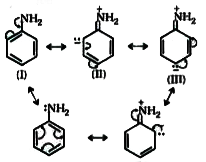What is the effect of resonance? Write about its types ?
Text Solution
The resonance effect is defined as the polarity produced in the molecule by the interaction of two π-bonds or between a π-bond and lone pair of electrons present on an adjacent atom. The effect is transmitted through the chain. These are two types as resonance or mesomeric effect designed of R or M effect.
(a) Positive resonance (+R) or mesomeric (+M) effect: (i) Definition: When the transfer of electron is away from an atom or substituent group attached to the conjugated system. This electron displacement makes certain positions in the molecule of high electron densities. So this is called positive resonance (+R) effect. (ii) e.g. In aniline −OH group containing (+R) and (+M) effect and the non-bonding electron pair of N is transfer in benzene ring and aniline becomes polar. Due to this effect the electron density is increases at some position.

Its structure (II, III) and (IV) are polar and lone pair electron of ..N at definite position and negative charge and more electron density. (iii) The other examples of +R or +M effect containing groups are as under. −X,−OH,−OR,−OCOR,−NH2,−NHR,−NR2−NHCOR
(b) Negative resonance effect (-R) or negative mesomeric effect (-M): (i) Definition: When the transfer of electron is towards the atom or substituent group attached to the conjugated system then these groups are called (-R) or (-M) effect.
(ii) e.g. : In nitrobenzene, −NO2 group containing (-R) means (-M) effect and the electron pair of π-bond with N of out side of ring. Therefore nitrobenzene molecule become polar and at certain position the electron density decrease in ring and become positive

Structure (II), (III), (IV) are polar. The electron pair of ring transfer at out side in O-N bond and (+) charge is at specific position and electron density is less
(iii) (-R) means (-M) effect containing groups are −COOH,−CHO,>C=O,−CN,−NO2
|
Topper's Solved these Questions
- ORGANIC CHEMISTRY SOME BASIC PRINCIPLES AND TECHNIQUESBOOK - KUMAR PRAKASHANCHAPTER - ORGANIC CHEMISTRY SOME BASIC PRINCIPLES AND TECHNIQUESEXERCISE - Section -A(Methods of Purification of Organic Compounds)
44 Videos
- ORGANIC CHEMISTRY SOME BASIC PRINCIPLES AND TECHNIQUESBOOK - KUMAR PRAKASHANCHAPTER - ORGANIC CHEMISTRY SOME BASIC PRINCIPLES AND TECHNIQUESEXERCISE - Section -A (Qualitative Analysis of organic compounds)
12 Videos
- ORGANIC CHEMISTRY SOME BASIC PRINCIPLES AND TECHNIQUESBOOK - KUMAR PRAKASHANCHAPTER - ORGANIC CHEMISTRY SOME BASIC PRINCIPLES AND TECHNIQUESEXERCISE - Section A (Fundamental Concepts in Organic Reaction Mechanism
10 Videos
- HYDROGENBOOK - KUMAR PRAKASHANCHAPTER - HYDROGENEXERCISE - Section-D NCERT Exemplar (Long Answer)
8 Videos
- QUESTION ASKED IN JEE -2018BOOK - KUMAR PRAKASHANCHAPTER - QUESTION ASKED IN JEE -2018EXERCISE - MCQ
10 Videos
Similar Questions
Knowledge Check
What is not true about resonance?
AThe resonating structures are hypothetical.BThe unpaired electrons in various resonating structures are same.CHybrid structure is least stable.DHybrid structure is least energetic.Which of the following is not true about resonance ?
AThe resonating structures are hypotheticalBThe unpaired electrons is various resonating structures are the sameCHybrid structure is less stableDHybrid structure is least energetic
What is electrocardiogram ? Write about its significance.
View SolutionWhat is electrocardiogram? Write about its significance.
View SolutionWhat is reflex action? Write its types and two examples.
View SolutionWhat effect will the resonance have on the dipole moment of vinyl chloride?
View SolutionWrite about different types of diseases.
View SolutionWhat are sexually transmitted diseases? Write its various types of preventive measures.
View Solution
